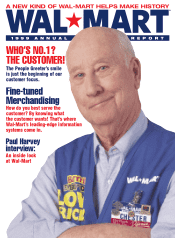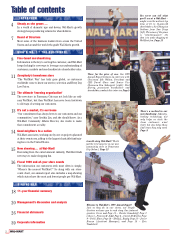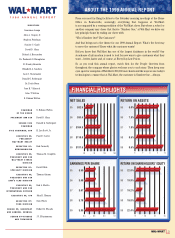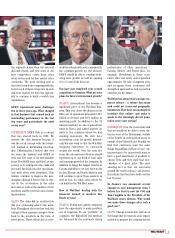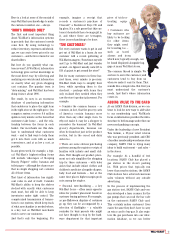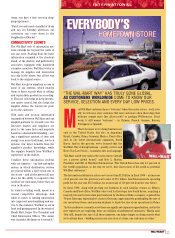Walmart 1999 Annual Report Download - page 4
Download and view the complete annual report
Please find page 4 of the 1999 Walmart annual report below. You can navigate through the pages in the report by either clicking on the pages listed below, or by using the keyword search tool below to find specific information within the annual report.
al-Mart has just completed
its best year ever, with sales
of over $137 billion in fiscal
1999, up 17%, which is almost $20 billion
more than last year. More importantly,
Earnings Per Share increased by 27 per-
cent, Return on Assets improved to 9.6
percent and the company paid dividends
of almost $700 million to shareholders.
Now we all know and appreciate the
associates in our local Wal-Mart, but
let’s take this opportunity to talk to the
leaders of Wal-Mart and ask them why
this group of people is so successful
and what challenges lie ahead this
next year. As shareholders you know
the results! Now, the rest of the story.
Wal-Mart had a record year in fis-
cal 1999. How do you explain the
tremendous performance and how
will you continue to deliver similar
shareholder results in the future?
DAVID GLASS: This year things came
together about as well as you could
expect. The economic environment was
good, our associates did a great job of
getting the right merchandise in the
stores, our stores executed their plans
very well and our customers continued
to exhibit their confidence in us by
spending their hard-earned dollars in
our stores and clubs.
Although we did have the best year in
our history, we look at many things we
could have done better and just how
much in the way of sales and profits we
left on the table. Every time we are out
of stock on an item that a customer
wants, every time we spend more than
we need to build a store, every time we
fail to meet a customer’s expectations
and they leave unhappy – each of these
are examples of where we can improve.
How do we continue to deliver future
results? One store at a time, one cus-
tomer at a time.
You have commented that this year’s
results exceeded your own expecta-
tions. What were the positive factors
that provided the upside surprises for
your company?
ROB WALTON: Clearly we were a bene-
ficiary of a strong U.S. economy, low
inflationary environment, continuing
improvements on the food side of our
business and a superb performance by
some of our international markets like
Canada and Puerto Rico. The single
biggest positive had to be the diligence
and level of execution on the part of our
associates and partners around the
globe. Every division exceeded its
business plan and I believe we worked
together as a team better than ever in
the past.
If the economy slows down, what will
be the impact on Wal-Mart?
DON SODERQUIST: If the economy does
tighten, we must make sure that we take
care of the customer and pick up market
share. We recognize that today’s level of
consumer optimism is not sustainable
forever, but we don’t see any current
signs that things are slowing.
Traditionally we have fared better than
our competition during downturns as
the consumer focus shifts toward value,
and that is exactly what our Every Day
Low Price program is all about.
What was the biggest challenge in the
year? Why?
WALTON: The biggest challenge was our
competition! They continue to get better
and better and it forces us to constantly
strive to improve every aspect of our
business. In the past we competed with
INTERVIEW
4
STEADY
W
PAUL HARVEY, ONE OF THE MOST
RECOGNIZED NAMES AND VOICES IN
AMERICA AND A WAL-MART SHARE-
HOLDER, INTERVIEWS ROB WALTON,
CHAIRMAN; DAVID GLASS, PRESIDENT
AND CEO; AND DON SODERQUIST, SENIOR
VICE CHAIRMAN; TO UNDERSTAND WHERE
THE COMPANY GOES FROM HERE.
STEADY
AS SHE GROWS

